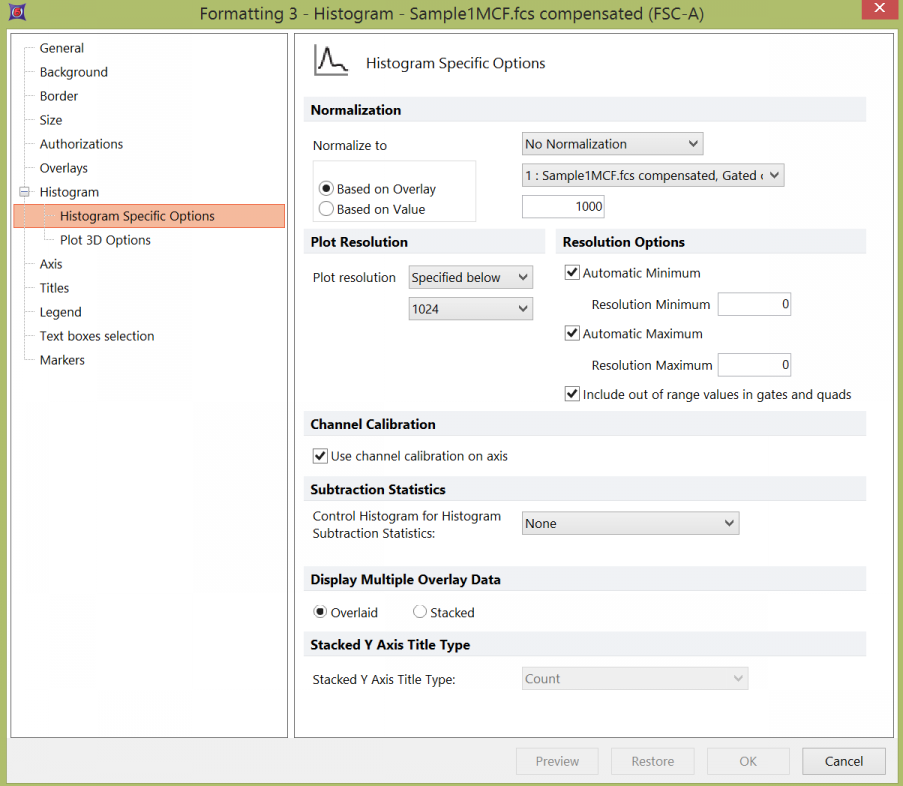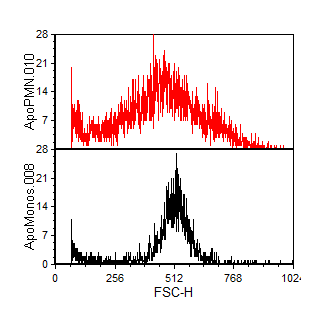Histogram Specific Options
The Histogram Specific Options category contains a variety of properties that control how data on the histogram is displayed.
You can edit histogram specific options in one of two ways:
•Select the histogram(s) and use the Format→Plot Options→Specific Options command.
•Right-click on the histogram, select Format from the pop-up menu, and choose the Histogram→Histogram Specific Options category (Figure 8.88).

Figure 8.88 Formatting Histogram Specific Options
The options are described in the table below. See Resolution Overview for a further description of resolution options.
Option |
Explanation |
|---|---|
If different overlays contain different numbers of events in a channel, they may not look alike even if the data comes from an identical population. Overlays can be normalized based on the number of events or based on the peak value. The reference, for both the number of events or the peak value, can be an overlay (select the Based on Overlay radio button and select an overlay from the drop-down list. The number of events in other overlays will be normalized to appear to have the same number of events as the selected overlay.) or a custom value (select the Based on Value radio button and type the custom value in the corresponding field). |
|
Plot resolution |
In the first drop-down menu, choose whether to use the resolution specified in the data or select your own resolution from the second drop-down menu. Choosing a resolution lower than the true resolution of the plot is an effective way of smoothing your data. |
Automatic Minimum |
If this is checked, then FCS Express will start binning the data (dividing it into the number of bins specified by the Plot resolution) at either 0 or the lowest data value (if the lowest data value is below 0). |
Resolution Minimum |
Specify where to start binning the data. If Automatic Minimum is checked, then this value is ignored. |
Automatic Maximum |
If this is checked, then FCS Express will finish binning the data (subdividing it into the number of channels specified by the Plot resolution) at the highest value of the true data range. |
Resolution Maximum |
Specify where to finish binning the data. If Automatic Maximum is checked, then this value is ignored. |
Include out of range values in gates and quads |
If this is checked, data values that are outside the resolution options of the plot will be considered to be part of the lower or upper channels. If a gate or quadrant touches the lower or upper channels, it will include these cells, even though the cells are actually outside the boundary of the gate/quadrant. |
Use channel calibration on axis |
FCS Express can establish calibrated values for the axes. If channel calibrations are defined, toggling this checkbox will determine whether or not to use the calibrated values in place of the generic channel numbers. |
FCS Express can automatically perform histogram subtraction to calculate the number of positive cells. Select which overlay is the control. |
|
Display multiple overlay data |
Display overlay data in a single histogram (Overlaid) or use a split view (Stacked). See Figure 8.89. |
If multiple overlay data is displayed Stacked, choose the Y Axis Title to use. |

Figure 8.89 A Histogram with Two Overlays in Stacked View
